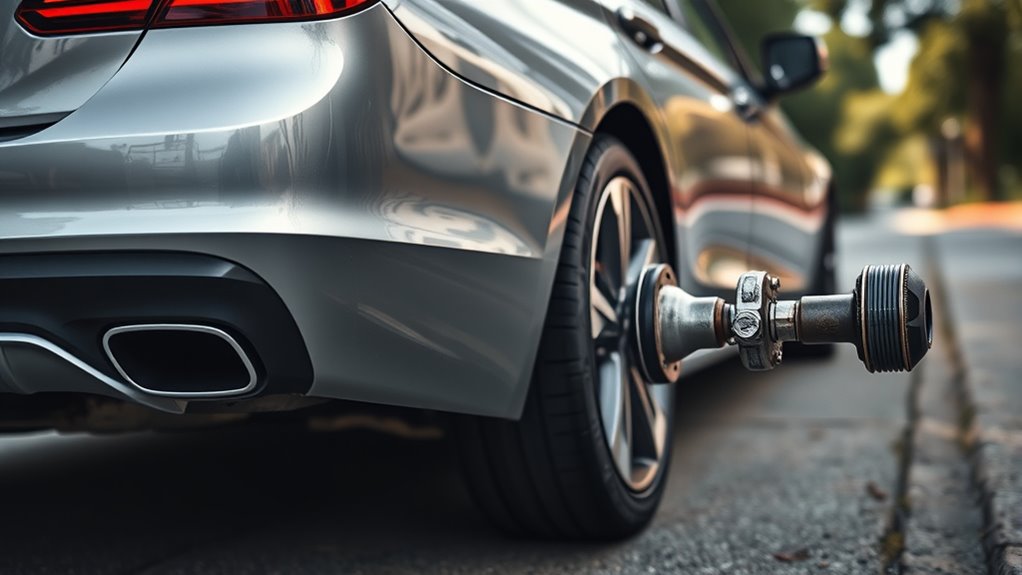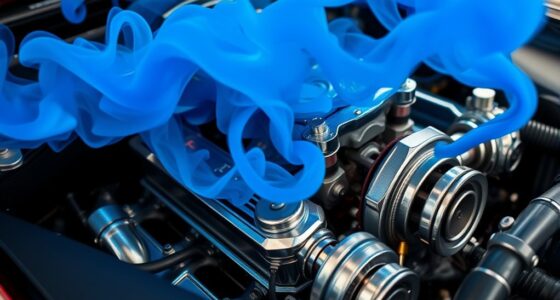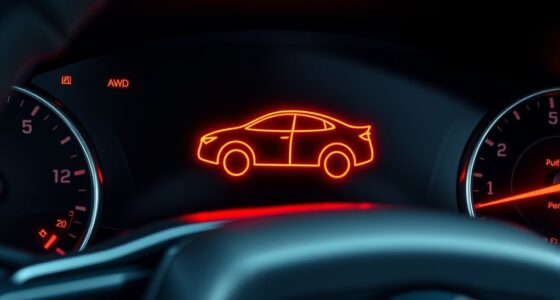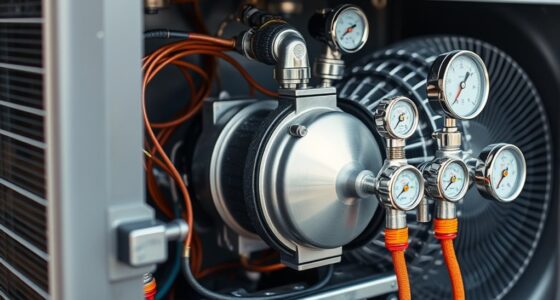To pinpoint the source of a driveline clunk or shudder, start by noting when it occurs—during acceleration, deceleration, or shifting. Check for visible damage or wear on components like the driveshaft, U-joints, CV joints, and engine or transmission mounts. Also, monitor fluid levels and condition. Addressing these issues early can prevent further damage. Continue exploring to learn more about inspecting and fixing these common driveline problems effectively.
Key Takeaways
- Observe when the clunk or shudder occurs (acceleration, deceleration, shifting) to narrow down potential causes.
- Inspect driveshafts and U-joints for visible damage, wear, or excessive play.
- Check engine and transmission mounts for deterioration or breakage that could cause shifting noises.
- Evaluate transmission fluid levels and condition to identify slipping or rough gear engagement.
- Listen for knocking sounds or vibrations that indicate worn CV joints or imbalanced driveshaft components.
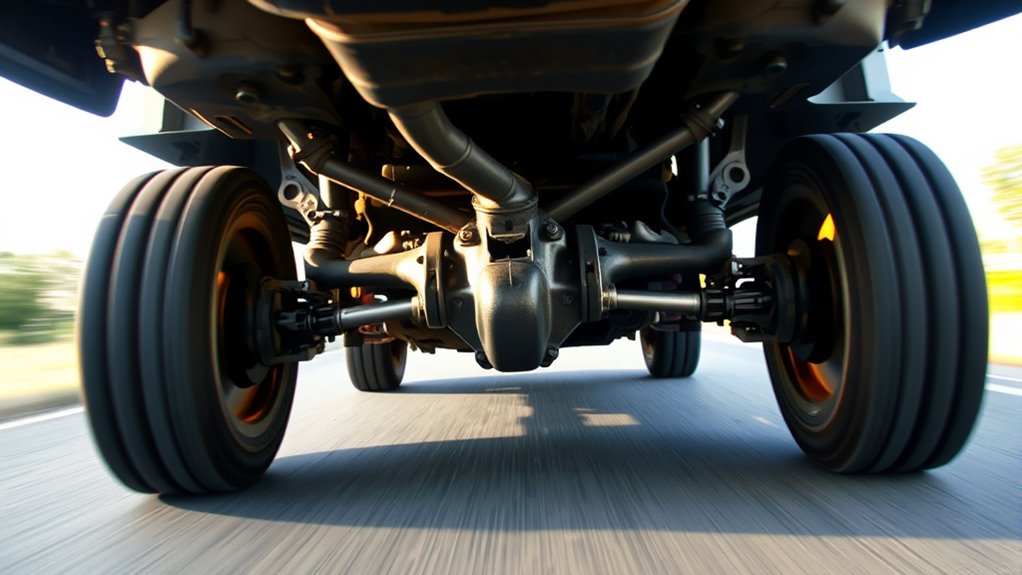
If you’ve noticed a clunk or shudder when shifting gears or accelerating, you’re likely dealing with a driveline issue. These sensations can be unsettling, but understanding what causes them can help you identify the problem more quickly. The driveline includes components like the driveshaft, CV joints, U-joints, and transmission, all working together to transfer power from your engine to the wheels. When any part of this system malfunctions, it can lead to noticeable jolts or vibrations.
Start by paying close attention to when the clunk or shudder occurs. Does it happen during acceleration, deceleration, or when shifting gears? If it mainly happens during acceleration, it could be a sign of worn or damaged CV joints or U-joints. These joints allow your wheels to turn and move smoothly, but over time, they can wear out or become loose, causing knocking sounds or shudders.
If the problem occurs during gear shifts, the issue might involve your transmission or the linkage connecting it to the engine. Sometimes, a slipping transmission or low fluid levels can cause abrupt movements or shudders.
Next, consider the condition of your driveshaft. If it’s bent, damaged, or has worn universal joints, it can produce a noticeable clunk during acceleration or deceleration. You might also feel a slight vibration or wobble. Inspect the driveshaft for visible damage or imbalance, which can stem from impacts or corrosion.
Worn U-joints are common culprits; they can develop play, leading to clunks as they move excessively when you accelerate or shift gears.
Another common cause relates to engine and transmission mounts. If these mounts deteriorate or break, your engine and transmission can shift slightly under load, creating knocking sounds or shudders. While these issues mightn’t always be obvious, they often become more noticeable in specific driving conditions, like taking off from a stop or during sudden acceleration.
Finally, don’t overlook the importance of fluid levels. Low transmission fluid can cause gear slippage and rough engagement, leading to shuddering sensations. Regularly check your fluid levels and condition, and top up or replace it as recommended by your vehicle’s manufacturer. If the fluid is dirty or burnt, it can cause additional wear and irregular shifting.
Additionally, inspecting the condition of your vintage models and considering regular maintenance can help prevent some of these issues from worsening over time.
Frequently Asked Questions
Can Driveline Issues Cause Safety Concerns While Driving?
Yes, driveline issues can cause safety concerns while you’re driving. When the driveline malfunctions, it may lead to sudden shuddering, loss of control, or unexpected vibrations.
These problems can increase your risk of accidents, especially at high speeds or during turns. It’s essential to get your driveline inspected and repaired promptly to guarantee your vehicle remains safe and reliable on the road.
How Long Can I Drive With a Driveline Shudder Before Repairs?
You shouldn’t drive long with a driveline shudder, as it indicates a potential safety risk and further damage. If you notice the shudder, it’s best to get your vehicle inspected and repaired as soon as possible.
Continuing to drive can worsen the problem, leading to costly repairs and possibly leaving you stranded. For your safety, schedule an appointment promptly and avoid driving until the issue is resolved.
Are All Driveline Clunks Indicative of Serious Problems?
Not all driveline clunks mean serious problems, but you shouldn’t overlook them. Some noises are minor and can be caused by loose components or normal wear.
Other noises, however, may signal more significant issues like damaged CV joints or driveshafts. If you notice a clunk, it’s best to have a mechanic inspect it promptly.
Catching problems early can prevent costly repairs and ensure your vehicle stays safe and reliable.
What Is the Average Cost to Fix Driveline Shudder?
The average cost to fix driveline shudder varies between $150 and $1,000, depending on the cause.
If it’s a simple issue like worn driveshaft bushings or CV joints, you might pay around $150 to $300.
More complex problems, such as replacing the driveshaft or transmission components, can run up to $1,000 or more.
Always get a detailed estimate from a trusted mechanic to understand your specific repair costs.
Can Routine Maintenance Prevent Driveline Clunking or Shuddering?
Ever wonder if regular maintenance can stop driveline issues? Routine inspections and timely fluid changes definitely help prevent clunking or shuddering.
You should regularly check your transmission and driveshaft components, ensuring everything’s lubricated and in good shape. Don’t ignore odd vibrations or noises—address them early.
Staying proactive with maintenance not only keeps your vehicle running smoothly but also saves you from costly repairs down the road.
Conclusion
When you notice a driveline clunk or shudder, don’t brush it off—trust your instincts. Pinpointing the source early can save you from bigger headaches down the road. Whether it’s a simple fix or something more complex, addressing the issue promptly keeps you ahead of the game. Remember, a stitch in time saves nine, so don’t let small problems turn into costly repairs. Stay vigilant and keep your vehicle running smoothly.
